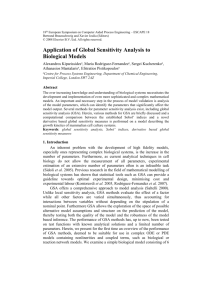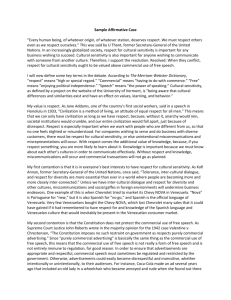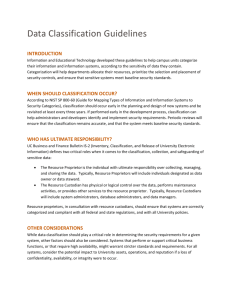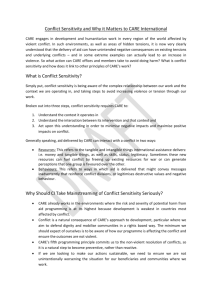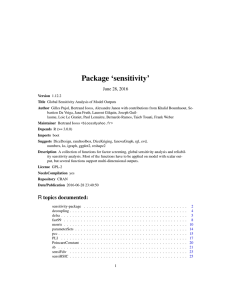Moment-Independent global sensitivity analysis with correlated input
advertisement
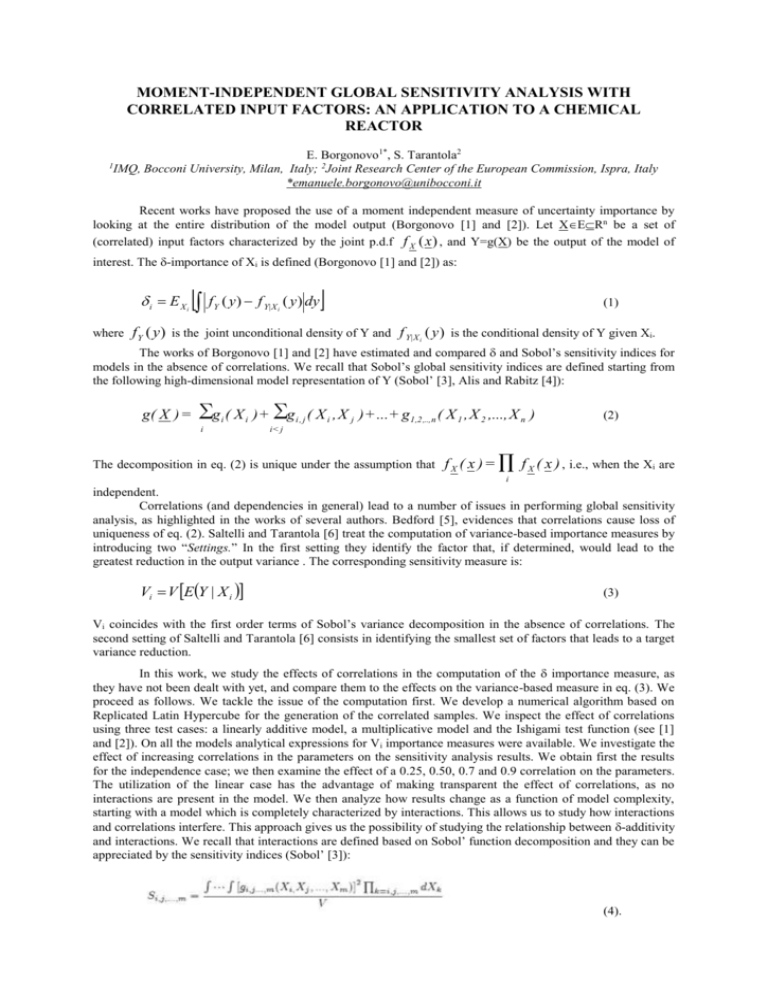
MOMENT-INDEPENDENT GLOBAL SENSITIVITY ANALYSIS WITH CORRELATED INPUT FACTORS: AN APPLICATION TO A CHEMICAL REACTOR 1 E. Borgonovo1*, S. Tarantola2 IMQ, Bocconi University, Milan, Italy; 2Joint Research Center of the European Commission, Ispra, Italy *emanuele.borgonovo@unibocconi.it Recent works have proposed the use of a moment independent measure of uncertainty importance by looking at the entire distribution of the model output (Borgonovo [1] and [2]). Let XERn be a set of (correlated) input factors characterized by the joint p.d.f f X (x ) , and Y=g(X) be the output of the model of interest. The -importance of Xi is defined (Borgonovo [1] and [2]) as: i EX where i f Y ( y ) f Y| X i ( y ) dy (1) f Y ( y) is the joint unconditional density of Y and f Y| X i ( y ) is the conditional density of Y given Xi. The works of Borgonovo [1] and [2] have estimated and compared and Sobol’s sensitivity indices for models in the absence of correlations. We recall that Sobol’s global sensitivity indices are defined starting from the following high-dimensional model representation of Y (Sobol’ [3], Alis and Rabitz [4]): g( X ) = ∑g i ( X i ) +∑g i , j ( X i , X j ) + ... + g 1,2 ,.., n ( X 1 , X 2 ,..., X n ) i (2) i< j The decomposition in eq. (2) is unique under the assumption that f X ( x ) = ∏ f X ( x ) , i.e., when the Xi are i independent. Correlations (and dependencies in general) lead to a number of issues in performing global sensitivity analysis, as highlighted in the works of several authors. Bedford [5], evidences that correlations cause loss of uniqueness of eq. (2). Saltelli and Tarantola [6] treat the computation of variance-based importance measures by introducing two “Settings.” In the first setting they identify the factor that, if determined, would lead to the greatest reduction in the output variance . The corresponding sensitivity measure is: Vi V E Y | X i (3) Vi coincides with the first order terms of Sobol’s variance decomposition in the absence of correlations. The second setting of Saltelli and Tarantola [6] consists in identifying the smallest set of factors that leads to a target variance reduction. In this work, we study the effects of correlations in the computation of the importance measure, as they have not been dealt with yet, and compare them to the effects on the variance-based measure in eq. (3). We proceed as follows. We tackle the issue of the computation first. We develop a numerical algorithm based on Replicated Latin Hypercube for the generation of the correlated samples. We inspect the effect of correlations using three test cases: a linearly additive model, a multiplicative model and the Ishigami test function (see [1] and [2]). On all the models analytical expressions for Vi importance measures were available. We investigate the effect of increasing correlations in the parameters on the sensitivity analysis results. We obtain first the results for the independence case; we then examine the effect of a 0.25, 0.50, 0.7 and 0.9 correlation on the parameters. The utilization of the linear case has the advantage of making transparent the effect of correlations, as no interactions are present in the model. We then analyze how results change as a function of model complexity, starting with a model which is completely characterized by interactions. This allows us to study how interactions and correlations interfere. This approach gives us the possibility of studying the relationship between -additivity and interactions. We recall that interactions are defined based on Sobol’ function decomposition and they can be appreciated by the sensitivity indices (Sobol’ [3]): (4). If a model does not entail interactions and the parameters are independent, then all the S i , j ..., m are null and the n first order sensitivity indices sum to unity ( ∑S i = 1 .) One says that the model is additive. Similarly, if i =1 n ∑δ i = 1 holds, we say that -additivity holds. Considering different model structures, we explore what are the i =1 conditions under which a model is -additive and analyze whether the same conditions assure additivity of variance-based sensitivity results. We are then left with investigating the effects of dependencies on -additivity. Finally, we apply these procedures to a model for the stability of a chemical reactor, whose global sensitivity analysis has been discussed in Saltelli et al [7] for the independent input case. Acknowledgements: Financial support from Bocconi University is gratefully acknowledged by E. Borgonovo. References [1] Borgonovo E., 2006a: “A New Uncertainty Importance Measure,” Reliability Engineering and System Safety, to appear. [2] Borgonovo E, 2006: “Measuring Uncertainty Importance: Investigation and Comparison of Alternative Approaches,” Risk Analysis, 26 (5), pp. 1349-1362 [3] Sobol' I.M., 2003: "Theorem and Examples on High-Dimensional Model Representation," Reliability Engineering and System Safety, 79, 187-193. [4] Rabitz H. and Alis Ö. F., 1999: “General foundations of high-dimensional model representations,” Journal of Mathematical Chemistry, 25, no. 2-3, pp. 197--233. [5] Bedford T., 1998: “Sensitivity Indices for (Tree)- Dependent Variables,” Proceedings of the Second International Symposium on Sensitivity Analysis of Model Output, Venice (Italy), 1998, pp.17-20. [6] Saltelli A. and Tarantola S., 2002: “On the Relative Importance of Input Factors in Mathematical Models: Safety Assessment for Nuclear Waste Disposal,” Journal of the American Statistical Association, 97 (459), p. 702-709. [7] Saltelli A., Ratto M., Tarantola S. And Campolongo F., 2005: “Sensitivity Analysis for Chemical Models,” Chemical Reviews, 105 (7), pp. 2811-2827.

